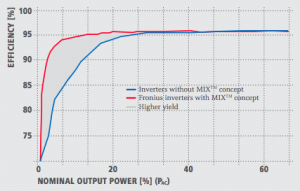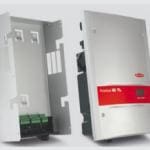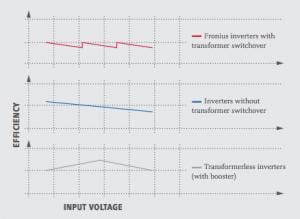Fronius is an international company with a 65 year history in the manufacture of welding equipment and nearly two decades of experience with solar inverters and other devices for monitoring and controlling energy, including battery chargers. Fronius inverters are suitable for a wide range of applications, including residential solar and commercial solar projects.
The importance of selecting the right inverter
Your solar system’s inverter is the point at which the DC electricity produced by your solar panels is turned into grid-compatible AC electricity. One of the most important decisions you will therefore make if you are considering having a solar system installed on your property is your choice of inverter. What questions should you ask about the inverter manufacturer and their products?
Most of these questions are obvious ones:
-How long has the company been around? Does it have a history of manufacturing any other products?
-Has the inverter been certified as having met the standards for grid connection (AS4777)?
-What is the efficiency of the inverter (read about the different types of inverter efficiency)?
-Does the capacity of the inverter a good match for those of your solar panel array (i.e. do the ‘sizes’ match?), and if not, can the inverter handle the disparity well?
-What kind of warranty does the inverter come with?
-What solar panel configurations are possible with the inverter, and does it have Maximum Power Point (MPP) tracking capability?
-Where is the inverter made?
Fronius inverters are from Austria. How important is this?
“Where are they made?” tends to be one of the first questions that many people ask when investigating having a solar power system installed. In general, there is a tendency for people to automatically think highly of anything that comes out of Germany, automatically (and often unfairly) look down on anything that comes out of China, and look fondly upon anything that has the label ‘made in Australia’.
Different countries have can have different standards for products produced within their borders, not all of which may be suitable for export to other countries. Every country also has its own standards for the import of products. In the case of the EU, for example, imports are required to be CE certified. The CE mark lets the purchaser know that the product in question has met the legislated EU requirements for that type of product. The idea is that the legislated standards should be sufficient to protect consumers from sub-standard products. In Australia the first port of call for whether a solar system component can be trusted or not is the Clean Energy Council’s (CEC) list of accredited components, which, as mentioned above, only includes inverters that have met or exceeded the minimum standards. All inverters, panels, and other solar system components installed through the Solar Choice Installer Network are CEC-approved.
Asking the ‘Where is it made?’question often simply reflects the fact that customers are looking for a ‘story’ about the company that makes sense to them, and that it are not simply a fly-by-night operation that has recently sprung up and could go under just as quickly. Fronius definitely has such a story: It is a family-owned Austrian company with a long history in other industries that has offices throughout the EU, North and South America, and Australasia, including a sales and service office in Melbourne.
The important thing to remember, however, is not necessarily where the product comes from, but what standards it has met, and what makes the component or company unique and distinguishable from others in the same market. This is true for solar panels, solar inverters, and all other balance of system components.
Fronius stands out for a number of reasons: innovative approaches to inverter design, excellent brand name with a long history in other industries, and a reputation for excellent customer service. The company has developed a number of innovative technologies which can be found in its diverse catalogue of inverters. The company offers 3 main lines of inverters: IG TL (Transformerless Inverters, available in rated AC outputs of 36.6kW, 51.4kW, and 64.4kW), IG Plus (Transformer Inverters, available in rated AC outputs of 3kW, 3.5kW, 4kW, 6.5kW, and 8kW), and IG (Transformer Inverters, available in rated AC outputs of 1.3kW, 1.8kW, 2.5kW, 3.5kW, and 4.6kW).
Fronius Inverters: Points of Difference
–Peak efficiencies of up to 98% in some units

–Fronius MIXTM concept: a combination of several power modules in one Fronius inverter means that Fronius inverters always attain maximum yield, even in the partial load range (i.e. even in sub-optimal or cloudy conditions). The MIXTM concept also extends inverter service life, as a programmed algorithm automatically switches modules on and off as input voltage fluctuates–meaning that the workload is spread around evenly across internal components.
-Printed Circuit Board (PC Board) replacement concept – Fronius inverters are designed with PC board replaceability in mind, so that the entire unit does not need to be disassembled in the event that an issue arises.

–Inverters equipped with monitoring devices can be tracked online by Fronius and your installer, so that troubleshooting can be conducted from a distance and expensive site-visits for simple issues may be avoided. Online monitoring devices are standard with all IG TL inverter models and are available as options for other modules. (See a sample of how inverter data can be viewed online. Click ‘sample system’ at the bottom of the page.)
-The Fronius Mounting System: The connection compartment and power module compartment on Fronius inverters can be easily separated. The compartment containing all the cables is mounted on the wall, and the power module compartment can be easily removed for servicing.
–Ventilation concept: All inverters get hot while operating and need to be cooled. Ventilation ducts that pass over the cooling element in Fronius inverters are hermetically sealed, so that outside air which may be carrying dust or other particulate matter never comes in direct contact with the sensitive internal electrical parts. This is one other measure that Fronius takes to ensure the longevity of its inverters.

–High-frequency transformer switchover: Fronius’ transformer inverters (IG and IG Plus) contain an automatic transformer switchover facility that produces three efficiency peaks, which means a more constant level of efficiency over the operating input voltage range. Many inverters have simply drop from high to low.
-Under a special promotion running until 31 December 2011, customers who extend their warranty from the standard 5 years to 10 will receive an additional 10 years of warranty protection (pdf) at no added cost–20 years in total.
Other products by Fronius
In addition to solar inverters and solar system monitoring equipment, the solar electronics division of Fronius also manufactures fuel cells and provides training in the use of its products for its partners in the industry. The other divisions of Fronius are battery charging systems and welding technology.
Component standards met/awards
-All models of Fronius inverters are certified by the Clean Energy Council (CEC) of Australia, and are on the list of CEC-approved components.
–CE mark– Fronius inverters are compliant with European Union regulations
About Fronius
-Headquarters and factories-
Headquarters: Wels, Austria
Australian Sales and Service office: Melbourne, Australia
Fronius inverters for the Australian market are manufactured in Sattledt, Austria
Fronius also has production facilities in Canada, and the Czech Republic
-History in the industry-
Fronius has was established in 1945 as a welding equipment manufacturer, and has been involved in inverter manufacturing since 1992. Fronius is a family owned company.
- Solar Hot Water System: Everything You Need to Know - 27 February, 2024
- Enphase Battery: An Independent Review by Solar Choice - 20 January, 2024
- Can I add more panels to my existing solar system? - 8 August, 2023
I have signed up with Euro solar , however they say I could have a 3 phase 5-20 kw FRONIUS inverter for an extra aud $ 800 with a 10 year warranty .
Being that I am altering their supply of a 3 phase 5- 20 kw ZEVER SOLAR. I wanted to make contact with a Fronius supplier here in Western Australia to discuss the matter.
Cheers
D R Shaw
can you please tell me if I am better off with a froniuf inverter or a abb inverter and why thanks mick.
Hi Mick,
Both inverter brands have a pretty good reputation in Australia. Ask them about their customer service and warranties in order to compare them in a bit more detail. Fronius also runs a free extended 10-year warranty which will be available until 30 June 2016. Check if ABB/Power-One offer something similar.